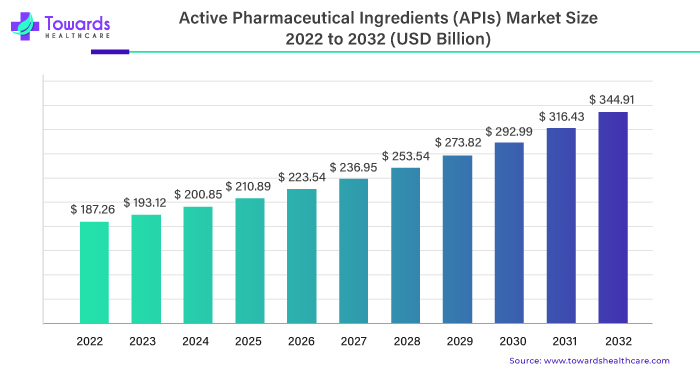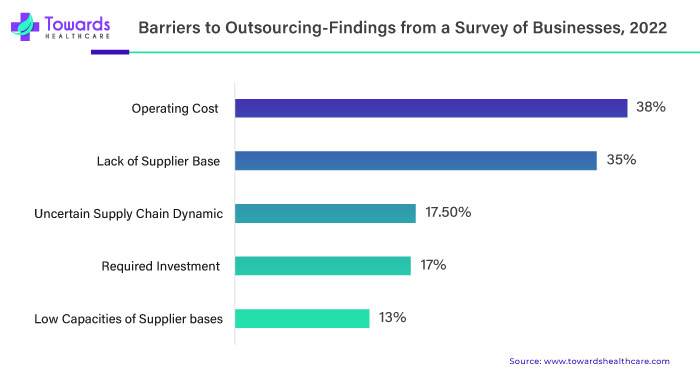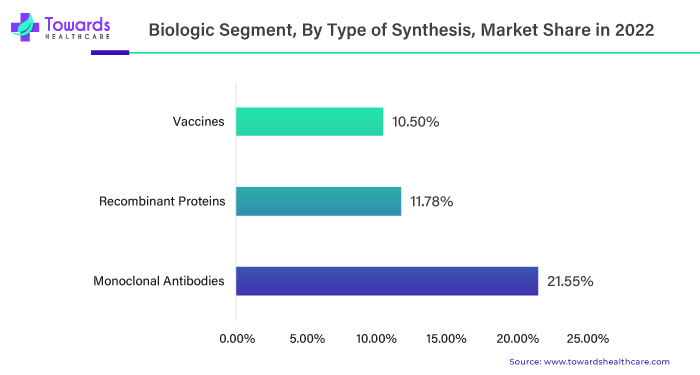
The global active pharmaceutical ingredients market size is estimated to grow from USD 187.26 billion in 2022 to surpass around USD 344.91 billion by 2032, expanding at a CAGR of 6.66% between 2023 and 2032, as a result of the rising demand of medications and rising disease prevalence.
Report Highlights:
- North America dominated the global active pharmaceutical ingredients market with around USD 78.19 billion in 2022.
- Asia Pacific is estimated to grow at the fastest rate of 7.08% from 2023 to 2032.
- By type of synthesis, the synthetic segments exhibited the largest market share of around 55.84% in 2022.
- By application, the oncology segment is projected to be the fastest growing segment with around 7.62% CAGR from 2023-2032.
- FDA Impact:
- Approval of 55 new drugs by the US Food and Drug Administration in 2023 significantly accelerates market growth.
- APIs Overview:
- Active pharmaceutical ingredients market are chemical compounds vital for medications.
- Mainly manufactured in the United States, Europe, China, and India.
- Used alongside other ingredients to diagnose, cure, and treat diseases.

US Food and Drug Administration approvals of 55 new drugs in 2023 significantly accelerated growth in the active pharmaceutical market.
Active pharmaceutical ingredients market, chemical compounds vital for medication, are mainly manufactured in the United States, Europe, China and India. These substances, with pharmacological properties, are commonly used alongside other ingredients to diagnose, cure, and treat diseases. Recently, pharmaceutical companies have started importing APIs from producing countries. Modern medicines for disease prevention, treatment, diagnosis and cure consist of two primary components. The API, the active and biologically effective core, performs the necessary actions in the body. Excipients, like lactose or mineral oil, are chemically inactive, providing volume, flavour or colour, aiding API delivery throughout the body.
For Instance,
- According to NIH, the primary purpose of APIs is to treat diseases directly through their pharmacological activity in combination with inactive forms. Globally, nearly 1 lakh tons of pharmaceutical products are consumed, with Europe accounting for up to 24% of medicinal product consumption.
Continuous monitoring and reporting are integral components of compliance efforts. Generating and maintaining extensive documentation, including batch records, stability data and adverse event reporting, are essential. This ongoing commitment to compliance demands a dedicated workforce and robust technology infrastructure. The active pharmaceutical market focuses on producing and selling active pharmaceutical ingredients market or drugs with therapeutic effects. This market is crucial in developing and manufacturing medications for various medical conditions.
The active pharmaceutical ingredients market has witnessed significant growth in recent years due to increased demand for innovative treatments, advancements in research and development and the global expansion of healthcare infrastructure. Technological innovations, regulatory reforms and a growing ageing population have further fueled this growth. The market has expanded significantly, driven by scientific progress, demand and regulatory changes.
Ageing Population Rises Demand for Active Pharmaceutical Ingredients Market
The ageing population has contributed to the growth of the active pharmaceutical ingredients market due to an increased prevalence of age-related health issues. As people age, there is a higher demand for pharmaceuticals to address conditions such as cardiovascular diseases, diabetes and neurodegenerative disorders. This demographic shift has driven pharmaceutical companies to focus on developing and producing a broader range of APIs to meet the rising healthcare needs of older people.
- In 2023, a meta-analysis of 94 studies representing over 371 million older adults in 17 countries assessed the global prevalence of Potentially Inappropriate Medication (PIM) used in outpatient services due to PIM raising innovation and production of active pharmaceutical ingredients market.
- PIM use was prevalent in 36.7 per cent of the population, with benzodiazepines being the most common PIM. PIM usage has increased over the last two decades, particularly in high-income countries.
- The risk of dementia and Alzheimer’s disease increased in a dose-response relationship with the use of anticholinergic drug classes (primarily first-generation antihistamines, tricyclic antidepressants and bladder antimuscarinics) in a population of 3434 adults age 65 and older in one health care setting who had no baseline dementia and were followed for 10 years.
- In a US Department of Veterans Affairs (VA) outpatient population of 75-year-old patients, 65 per cent had inappropriate medications.
- In 2021, According to WHO, 296 million individuals (or 5.8% of the world’s population between the ages of 15 and 64) reported using drugs at least once. Of them, 60 million or so were opioid users.
Additionally, advancements in medical research and technology have led to the discovery of new APIs that target specific ailments associated with ageing. These developments have spurred innovation in the pharmaceutical industry, leading to the expansion of the APIs market.
Furthermore, globalization and increased access to healthcare services have widened the market for APIs. Emerging economies with growing ageing populations are becoming significant consumers of pharmaceutical products, driving the demand for APIs on a global scale. The ageing population’s impact on the APIs market is multifaceted, encompassing increased demand for pharmaceuticals, advancements in medical research, stringent regulatory standards and global market expansion. These factors collectively contribute to the continuous growth and evolution of the APIs market.
- Ageing Population Impact:
- Age-related health issues contribute to market growth.
- Increased demand for pharmaceuticals to address conditions like cardiovascular diseases, diabetes, and neurodegenerative disorders.
- Global prevalence of Potentially Inappropriate Medication (PIM) in older adults leads to innovation and API production.
- Medication Demand and Growth:
- Escalating global population and ageing demographics increase healthcare needs.
- Outbreaks of new diseases or resurging existing ones intensify the demand for specific medications.
- Center for Drug Evaluation and Research (CDER) approval of 37 new drugs in 2022.
- Challenges in Compliance:
- Substantial cost of compliance poses challenges.
- Stringent regulatory requirements, including Good Manufacturing Practices (GMP) and Good Laboratory Practices (GLP).
- Compliance efforts require extensive documentation, validation studies, and routine testing.
Rising Medication Demand Drives Robust Growth in the Active Pharmaceutical Ingredients Market
The surge in demand for medication plays a pivotal role in propelling the growth of the active pharmaceutical ingredients market, manifesting through various critical facets. Firstly, the escalating global population and ageing demographics increase the prevalence of diverse medical conditions. This upsurge in healthcare needs necessitates heightened pharmaceutical production, subsequently driving the demand for active pharmaceutical ingredients market as essential components in drug formulation.
Additionally, outbreaks of new diseases or the resurgence of existing ones create a dynamic scenario that amplifies the demand for specific medications. This situation necessitates rapid development and production of pharmaceuticals, intensifying reliance on APIs manufacturers to promptly supply the necessary ingredients.
For Instance,
- The Center for Drug Evaluation and Research (CDER) of the US Food and Drug Administration (FDA) approved 37 new drugs in 2022, significantly decreasing from the 50 new drugs approved in 2021 and the 53 new drugs approved in 2020.

FDA Approved Drugs in Recent Years
| Sr. No | FDA Approval Date | Active Ingredient | Indication |
| 1. | 28 December 2022 | Anacaulase-bcdb | To remove eschar in adult with full thickness thermal burns |
| 2. | 22 December 2022 | Mosunetuzumab-axgb | To treat adult with HIV |
| 3. | 18 November 2022 | Teplizumab-mzwv | To delay the onset of stage 3 type of 1 Diabetes |
| 4. | 14 November 2022 | Mirvetuximab soravtansine-gynx | To treat patient with recurrent ovarian cancer |
| 5. | 27 October 2023 | Mirkizumab-mrkz | To treat ulcerative colitis |
| 6. | 15 November 2023 | Repotrectinib | To treat ROS1-positive non-small cell lung cancer |
| 7. | 18 December 2023 | Birch triterpenes | To treat wounds associated with dystrophic bullosa |
| 8. | 21 December 2023 | Eplontersen | To treat polyneuropathy |
Advances in medical research lead to the development of novel treatment modalities and therapeutic approaches. Introducing new medications or innovative formulations triggers an increased demand for APIs customized to these innovative pharmaceuticals. The increasing interconnectedness of the global healthcare landscape means that pharmaceutical companies are catering to diverse markets. There is a growing demand for active pharmaceutical ingredients market with varying specifications to meet the regulatory standards and specific healthcare needs of different regions, further stimulating the APIs market’s growth.
The trend towards precision medicine, where treatments are personalized to individual patients based on genetic, environmental and lifestyle factors, requires specialized pharmaceuticals. This customization often involves unique active pharmaceutical ingredients market formulations, fostering a demand for more diverse and specialized active ingredients.
Government initiatives to enhance healthcare access and favourable policies significantly boost medication demand. Such initiatives may include subsidized healthcare programs, vaccination campaigns or disease prevention efforts, all contributing to increased pharmaceutical production and APIs market growth—the overall demand for active pharmaceutical ingredients market as an integral part of the pharmaceutical supply chain.
Furthermore, the multifaceted increase in medication demand, driven by demographic shifts, disease dynamics, technological advancements and global healthcare initiatives, serves as a foundational driver for the expansion of the active pharmaceutical ingredients market.
Cost of Compliance Restrict the Growth of Active Pharmaceutical Ingredients Market
The active pharmaceutical ingredients market faces a formidable challenge in the form of the substantial cost of compliance. One key aspect contributing to this challenge is the global imposition of stringent regulatory requirements by health authorities. Pharmaceutical manufacturing must adhere to rigorous standards such as Good Manufacturing Practices (GMP) and Good Laboratory Practices (GLP). Achieving compliance necessitates establishing robust quality management systems, conducting regular audits and strict adherence to intricate documentation protocols.
A significant portion of the financial burden associated with compliance is directed towards investment in quality assurance and control. active pharmaceutical ingredients market manufacturers must invest substantially in measures such as establishing quality control laboratories, implementing comprehensive quality management systems and employing skilled personnel. These efforts are crucial for monitoring and ensuring the quality of the APIs throughout the entire manufacturing process.
Validation and testing costs further contribute to the financial strain on APIs manufacturers. Regulatory agencies often mandate extensive validation studies to demonstrate manufacturing processes’ consistency, efficacy and safety. These studies are not only time-consuming but also require significant financial resources. Routine testing of raw materials, intermediates and finished products adds a layer to the overall compliance costs. The regulatory filings and inspections process represents another substantial financial commitment for active pharmaceutical ingredients market manufacturers. Additionally, undergoing inspections by health authorities incurs additional costs. Any deficiencies identified during inspections may result in the need for corrective actions, further escalating expenses.
Continuous monitoring and reporting are integral components of compliance efforts. Generating and maintaining extensive documentation, including batch records, stability data and adverse event reporting, are essential. This ongoing commitment to compliance demands a dedicated workforce and robust technology infrastructure. Global harmonization challenges add another layer of complexity. Divergent regulatory requirements across different regions and countries complicate compliance efforts, necessitating companies to adapt to various standards and undergo multiple approval processes.
For Instance,
- A survey of companies in the pharmaceutical industry revealed that, from their perspective, the operating cost in Europe due to higher personnel costs and a lack of nearby supplier bases, such as for critical materials, are significant barriers to outsourcing production in Europe.

Integration of APIs and Biomasses Sets New Future Prospects
The active pharmaceutical ingredients market presents a promising future with the integration of biomass recycling and conversion. Overcoming challenges in consumer demand and business opportunities, the Active Pharmaceutical Ingredients Committee (APIC) emphasizes the need for streamlined approaches in identifying novel technologies within the circular economy. Advantages in biomass utilization, APC conversion, effective waste recycling, and management policies are crucial.
Recent biotechnological advancements, including genetic engineering and bioengineering, contribute to developing microbial strains and models, enhancing biomass yield, CO2 utilization, lipid accumulation and bioremediation. Integrating various technologies and computer engineering is critical to achieving a circular economy for valuable bioproducts like APC and biofuels. The efficient utilization of biomass raises questions, particularly regarding the substantial agricultural waste often burned due to a lack of knowledge or modern equipment availability.
Additionally, with a focus on sustainability, cost-effectiveness and renewable energy resources, industries seek long-term solutions for organic biomass recycling. The conversion of biomass to APC becomes a significant approach, addressing the demand in the pharmaceutical industry. Despite the growing interest, critical problems and challenges associated with biomass recycling and APC conversion require global scientific attention.
The integration of metagenomics techniques emerges as valuable evidence. These techniques offer a better understanding of the mechanisms, metabolic pathways and system biology approaches of microorganisms involved in the biomass-to-APC conversion process. This integration opens new opportunities and contributes to the expansion of the APIs market.
Monoclonal Antibodies hold a Significant Share of the Active Pharmaceutical Ingredients Market
Monoclonal Antibodies’ Significance:
- Monoclonal antibodies significantly impact API market growth.
- Precise targeting in treating diseases like cancer and autoimmune disorders.
- Over 24 investigational antibody therapeutics reviewed by regulatory agencies worldwide in November 2022.
Monoclonal antibodies have significantly impacted the active pharmaceutical ingredients market by driving growth through therapeutic advancement. Their precise targeting in treating various diseases, including cancer and autoimmune disorders, has increased demand for active pharmaceutical ingredients (APIs) in their production. This trend is likely to continue as research and development efforts focus on expanding the therapeutic applications of monoclonal antibodies.
Monoclonal antibodies have found applications in treating many diseases, including but not limited to cancer, rheumatoid arthritis, multiple sclerosis and inflammatory bowel diseases. This diverse range of applications contributes to the growing demand for APIs.

Monoclonal antibody demand continues to rise and pharmaceutical companies invest in research and development to create innovative theories mainly for cancer, contributing to their market dominance in the active pharmaceutical ingredients market.
For Instances,
- In November 2022, according to the National Institute of Health, more than 24 investigational antibody therapeutics are were reviewed by regulatory agencies worldwide.
- In 2022, according to the National Institute of Health, 19 antibodies were granted for 1st approval.
US FDA Approved Monoclonal Antibodies
| Sr. No | US-FDA Approval Date | Brand Name | Indication |
| 1. | January 2022 | kimmtrak | To treat metastatic uveal melanoma |
| 2. | August 2022 | Tecvayli | To treat multiple myeloma |
| 3. | September 2022 | Opdualag | To treat melanoma |
Geographical Landscape
- North America leads due to rising illnesses, especially among the ageing population.
- US government actions may escalate operational costs for manufacturers.
- Europe has a diverse market with key players in Germany, Switzerland, and the UK.
- Asia Pacific, with countries like China and India, known for lower-cost API production, is expected to experience rapid growth.
North America currently lead the active pharmaceutical ingredients market due to rising illnesses, especially among the ageing population. The United States government’s current political and trade actions, such as increasing import tariffs and taxes, may escalate operational costs for manufacturers, potentially leading to price hikes. The Food and Drug Administration (FDA) has extended application fees for new drug approvals and increased random inspections of contract manufacturing facilities outside the U.S. to ensure high-quality products in the American market.
The active pharmaceutical ingredients market in Europe is diverse, with key players distributed across countries such as Germany, Switzerland and the United Kingdom. These regions boast advanced pharmaceutical industries and research facilities, contributing to the development and production of active pharmaceutical ingredients market. Regulatory standards, including those set by the European Medicines Agency, play a crucial role in shaping the landscape. Additionally, collaborations between pharmaceutical companies and research institutions further influence the geographical dynamics of the European API market.
The Asia Pacific region is projected to experience rapid growth. Countries like China and India, known for producing active pharmaceutical ingredients market at lower costs, contribute significantly. Additionally, the increasing healthcare expenditure in the region is expected to drive market expansion.
Recent Developments
- In 2023, Eisai Biogen got approval from the US Food and Drug Administration for using Lacanemab. It is used in the treatment of Alzheimer’s Disease.
- In 2023, the FDA approved Ryzneuta, a drug Evive Biotech and Acrotech Biopharma developed for treating chemotherapy-induced neutropenia.
- In 2021, Teva Pharmaceuticals and MEDinCell got approval from the FDA. It is used in the treatment of Schizophrenia.
Market Players
- Teva Pharmaceutical Industries Ltd.
- Pfizer Inc
- Novartis International AG
- BASF SE
- Dr. Reddy’s Laboratories Ltd
- Lonza
- Merck KGaA
- Boehringer Ingelheim
- Sun Pharmaceutical Industries Ltd
Market Segments
By Type of Synthesis
- Biologic
- Monoclonal Antibodies
- Recombinant Proteins
- Vaccines
- Synthetic
By Type
- Generic APIs
- Branded APIs
By Drug Type
- Prescription Drugs
- Over-the-Counter Drugs
By Application
- Cardiovascular Diseases
- Oncology
- CNS & Neurological Disorders
- Orthopedic Disorders
- Endocrinology
- Respiratory Disorders
- Gastrointestinal Disorders
- Nephrology
- Ophthalmology
- Others
By Geography
- North America
- Europe
- Asia-Pacific
- Latin America
- The Middle East and Africa
READ MORE RELATED PRESS RELEASE: Over-the-Counter Analgesics Market






